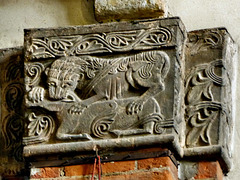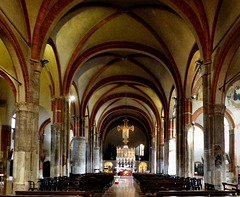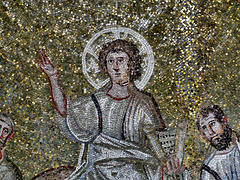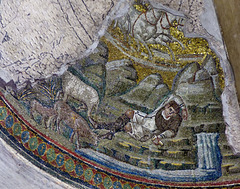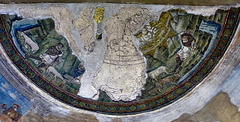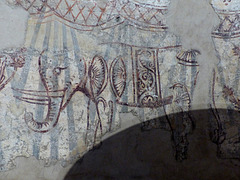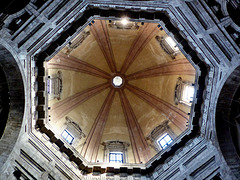Martin M. Miles' photos
Milan - Basilica di Sant'Eustorgio
| |
|
Milan is the city capital of the Lombardy and the second most populous city in Italy after Rome. Known during Roman times as "Mediolanum" it was the place, where in 313 Constantine I and Licinius met and "signed" the "Edict of Milan", giving Christianity a legal status within the Roman empire.
At the end of the Roman empire Milan was besieged by the Visigoths in 402, looted by the Huns in 452, and taken by the Ostrogoths in 539. Only 30 years later is belonged to the Kingdom of the Lombards, until in 774 Charlemagne defeated the Langobards and added Milan to the Carolingian empire. During Barbarossa´s (Frederik I) "Italian Campaigns" Milan was taken and destroyed to a great extent.
Only a few large structures survived the fury. One of them was the Basilica di San Lorenzo (see previous uploads). The Basilica di Sant'Eustorgio, located only about 500 ms south of the Basilica di San Lorenzo, existed already since centuries at that time, as it was founded in the 4th century. The name refers to Eustorgius I, the bishop of Milan (~350).
It is attributed to Eustorgius to have translated the relics of the Magi to the city from Constantinople in 344, a present of Roman Emperor Constantius II (337-361). This legend came up in the 12th century, when the "new" Basilica di Sant'Eustorgio was erected in Romanesque style.
When Milano was sacked by Frederick Barbarossa, the relics of the Magi were appropriated and subsequently taken to Cologne by his close advisor Rainald of Dassel, Archbishop of Cologne. Actually the relics are still in the Cologne Cathedral, where the are kept in the "Shrine of the Three Kings". Some fragments of the holy bones were sent back from Cologne to Milano in 1903.
Milano had been a center of pilgrimage over a long time, but since 1164 the relics of the Magi attracted a stream of pilgrims to Cologne, what was very important for that city.
From the 13th century the church was the main Milanese seat of the Dominican Order, who promoted its rebuilding - and radically altered it with the construction of the south transept, the main crossings and within the 15th century by adding chapels (for noble families). The alterations of the 17th and 18th century were elimimnated by the restyling work of the 19th century "recreating" the original Lombard Romanesque forms.
Some of the old Romanesque capitals still exist. Here is a "Master of the Beasts".
Milan - Basilica di Sant'Eustorgio
| |
|
|
Milan is the city capital of the Lombardy and the second most populous city in Italy after Rome. Known during Roman times as "Mediolanum" it was the place, where in 313 Constantine I and Licinius met and "signed" the "Edict of Milan", giving Christianity a legal status within the Roman empire.
At the end of the Roman empire Milan was besieged by the Visigoths in 402, looted by the Huns in 452, and taken by the Ostrogoths in 539. Only 30 years later is belonged to the Kingdom of the Lombards, until in 774 Charlemagne defeated the Langobards and added Milan to the Carolingian empire. During Barbarossa´s (Frederik I) "Italian Campaigns" Milan was taken and destroyed to a great extent.
Only a few large structures survived the fury. One of them was the Basilica di San Lorenzo (see previous uploads). The Basilica di Sant'Eustorgio, located only about 500 ms south of the Basilica di San Lorenzo, existed already since centuries at that time, as it was founded in the 4th century. The name refers to Eustorgius I, the bishop of Milan (~350).
It is attributed to Eustorgius to have translated the relics of the Magi to the city from Constantinople in 344, a present of Roman Emperor Constantius II (337-361). This legend came up in the 12th century, when the "new" Basilica di Sant'Eustorgio was erected in Romanesque style.
When Milano was sacked by Frederick Barbarossa, the relics of the Magi were appropriated and subsequently taken to Cologne by his close advisor Rainald of Dassel, Archbishop of Cologne. Actually the relics are still in the Cologne Cathedral, where the are kept in the "Shrine of the Three Kings". Some fragments of the holy bones were sent back from Cologne to Milano in 1903.
Milano had been a center of pilgrimage over a long time, but since 1164 the relics of the Magi attracted a stream of pilgrims to Cologne, what was very important for that city.
From the 13th century the church was the main Milanese seat of the Dominican Order, who promoted its rebuilding - and radically altered it with the construction of the south transept, the main crossings and within the 15th century by adding chapels (for noble families). The alterations of the 17th and 18th century were elimimnated by the restyling work of the 19th century "recreating" the original Lombard Romanesque forms.
Some of the old Romanesque capitals still exist. Here is a lion, killing an ass.
Milan - Basilica di Sant'Eustorgio
| |
|
|
Milan is the city capital of the Lombardy and the second most populous city in Italy after Rome. Known during Roman times as "Mediolanum" it was the place, where in 313 Constantine I and Licinius met and "signed" the "Edict of Milan", giving Christianity a legal status within the Roman empire.
At the end of the Roman empire Milan was besieged by the Visigoths in 402, looted by the Huns in 452, and taken by the Ostrogoths in 539. Only 30 years later is belonged to the Kingdom of the Lombards, until in 774 Charlemagne defeated the Langobards and added Milan to the Carolingian empire. During Barbarossa´s (Frederik I) "Italian Campaigns" Milan was taken and destroyed to a great extent.
Only a few large structures survived the fury. One of them was the Basilica di San Lorenzo (see previous uploads). The Basilica di Sant'Eustorgio, located only about 500 ms south of the Basilica di San Lorenzo, existed already since centuries at that time, as it was founded in the 4th century. The name refers to Eustorgius I, the bishop of Milan (~350).
It is attributed to Eustorgius to have translated the relics of the Magi to the city from Constantinople in 344, a present of Roman Emperor Constantius II (337-361). This legend came up in the 12th century, when the "new" Basilica di Sant'Eustorgio was erected in Romanesque style.
When Milano was sacked by Frederick Barbarossa, the relics of the Magi were appropriated and subsequently taken to Cologne by his close advisor Rainald of Dassel, Archbishop of Cologne. Actually the relics are still in the Cologne Cathedral, where the are kept in the "Shrine of the Three Kings". Some fragments of the holy bones were sent back from Cologne to Milano in 1903.
Milano had been a center of pilgrimage over a long time, but since 1164 the relics of the Magi attracted a stream of pilgrims to Cologne, what was very important for that city.
From the 13th century the church was the main Milanese seat of the Dominican Order, who promoted its rebuilding - and radically altered it with the construction of the south transept, the main crossings and within the 15th century by adding chapels (for noble families). The alterations of the 17th and 18th century were elimimnated by the restyling work of the 19th century "recreating" the original Lombard Romanesque forms.
Milan - Basilica di Sant'Eustorgio
| |
|
|
Milan is the city capital of the Lombardy and the second most populous city in Italy after Rome. Known during Roman times as "Mediolanum" it was the place, where in 313 Constantine I and Licinius met and "signed" the "Edict of Milan", giving Christianity a legal status within the Roman empire.
At the end of the Roman empire Milan was besieged by the Visigoths in 402, looted by the Huns in 452, and taken by the Ostrogoths in 539. Only 30 years later is belonged to the Kingdom of the Lombards, until in 774 Charlemagne defeated the Langobards and added Milan to the Carolingian empire. During Barbarossa´s (Frederik I) "Italian Campaigns" Milan was taken and destroyed to a great extent.
Only a few large structures survived the fury. One of them was the Basilica di San Lorenzo (see previous uploads). The Basilica di Sant'Eustorgio, located only about 500 ms south of the Basilica di San Lorenzo, existed already since centuries at that time, as it was founded in the 4th century. The name refers to Eustorgius I, the bishop of Milan (~350).
It is attributed to Eustorgius to have translated the relics of the Magi to the city from Constantinople in 344, a present of Roman Emperor Constantius II (337-361). This legend came up in the 12th century, when the "new" Basilica di Sant'Eustorgio was erected in Romanesque style.
When Milano was sacked by Frederick Barbarossa, the relics of the Magi were appropriated and subsequently taken to Cologne by his close advisor Rainald of Dassel, Archbishop of Cologne. Actually the relics are still in the Cologne Cathedral, where the are kept in the "Shrine of the Three Kings". Some fragments of the holy bones were sent back from Cologne to Milano in 1903.
Milano had been a center of pilgrimage over a long time, but since 1164 the relics of the Magi attracted a stream of pilgrims to Cologne, what was very important for that city.
From the 13th century the church was the main Milanese seat of the Dominican Order, who promoted its rebuilding. The current façade is a 19th-century reconstruction.
Milan - Basilica di San Lorenzo
| |
|
Milan is the city capital of the Lombardy and the second most populous city in Italy after Rome. Known during Roman times as "Mediolanum" it was the place, where in 313 Constantine I and Licinius met and "signed" the "Edict of Milan", giving Christianity a legal status within the Roman empire.
At the end of the Roman empire Milan was besieged by the Visigoths in 402, looted by the Huns in 452, and taken by the Ostrogoths in 539. Only 30 years later is belonged to the Kingdom of the Lombards, until in 774 Charlemagne defeated the Langobards and added Milan to the Carolingian empire. During Barbarossa´s (Frederik I) "Italian Campaigns" Milan was taken and destroyed to a great extent.
Milan came back and flourished, when in 1386 the construction of the cathedral began, the Basilica di San Lorenzo had survived about a 1000 years! It was built between the late 4th and early 5th centuries. Some scholars connect it to (Arian!) bishop Auxentius (355-372) others to Flavius Stilicho (359 – 408) a powerful "magister militum" in the Roman army and close relative of Thedodosius I.
Desasters like fires and earthquakes have hitten the Basilica different times, but it got rebuilt, renovated, reconstructed and of course altered may times. Today the Basilica di San Lorenzo is a "complex" of churches and chapels.
The central structure is a squarish tetraconch with four apses, one in each direction. The chapels radiate from the ambulatory.
The octagonal Cappella di Sant'Aquilino dates back to the 5th century (some scholars date it to the 4th. c.). It features some very interesting Paleochristian mosaics.
The only complete mosaic in the chapel depicts Christ among the Apostles. Here Christ is is young and without a beard, an icon that is often connected to Arianism (eg Ravenna, Arian Baptistery). The nimbus frames a Chrismon between Alpha and Omega.
Milan - Basilica di San Lorenzo
| |
|
|
Milan is the city capital of the Lombardy and the second most populous city in Italy after Rome. Known during Roman times as "Mediolanum" it was the place, where in 313 Constantine I and Licinius met and "signed" the "Edict of Milan", giving Christianity a legal status within the Roman empire.
At the end of the Roman empire Milan was besieged by the Visigoths in 402, looted by the Huns in 452, and taken by the Ostrogoths in 539. Only 30 years later is belonged to the Kingdom of the Lombards, until in 774 Charlemagne defeated the Langobards and added Milan to the Carolingian empire. During Barbarossa´s (Frederik I) "Italian Campaigns" Milan was taken and destroyed to a great extent.
Milan came back and flourished, when in 1386 the construction of the cathedral began, the Basilica di San Lorenzo had survived about a 1000 years! It was built between the late 4th and early 5th centuries. Some scholars connect it to (Arian!) bishop Auxentius (355-372) others to Flavius Stilicho (359 – 408) a powerful "magister militum" in the Roman army and close relative of Thedodosius I.
Desasters like fires and earthquakes have hitten the Basilica different times, but it got rebuilt, renovated, reconstructed and of course altered may times. Today the Basilica di San Lorenzo is a "complex" of churches and chapels.
The central structure is a squarish tetraconch with four apses, one in each direction. The chapels radiate from the ambulatory.
The octagonal Cappella di Sant'Aquilino dates back to the 5th century (some scholars date it to the 4th. c.). It features some very interesting Paleochristian mosaics, reminding stronly on the Byzantine mosaics in Ravenna (eg San Vitale, Sant’Apollinare Nuovo). .
This is the only still complete mosaic. Christ among the Apostles in a meadow between two streams. Christ is depicted as young (beardless!) with a nimbus framing a Chrismon between alpha and omega. Peter is on the right, Paulus on the left. A case with seven scrolls is in the foreground.
Milan - Basilica di San Lorenzo
| |
|
Milan is the city capital of the Lombardy and the second most populous city in Italy after Rome. Known during Roman times as "Mediolanum" it was the place, where in 313 Constantine I and Licinius met and "signed" the "Edict of Milan", giving Christianity a legal status within the Roman empire.
At the end of the Roman empire Milan was besieged by the Visigoths in 402, looted by the Huns in 452, and taken by the Ostrogoths in 539. Only 30 years later is belonged to the Kingdom of the Lombards, until in 774 Charlemagne defeated the Langobards and added Milan to the Carolingian empire. During Barbarossa´s (Frederik I) "Italian Campaigns" Milan was taken and destroyed to a great extent.
Milan came back and flourished, when in 1386 the construction of the cathedral began, the Basilica di San Lorenzo had survived about a 1000 years! It was built between the late 4th and early 5th centuries. Some scholars connect it to (Arian!) bishop Auxentius (355-372) others to Flavius Stilicho (359 – 408) a powerful "magister militum" in the Roman army and close relative of Thedodosius I.
Desasters like fires and earthquakes have hitten the Basilica different times, but it got rebuilt, renovated, reconstructed and of course altered may times. Today the Basilica di San Lorenzo is a "complex" of churches and chapels.
The central structure is a squarish tetraconch with four apses, one in each direction. The chapels radiate from the ambulatory.
The octagonal Cappella di Sant'Aquilino dates back to the 5th century (some scholars date it to the 4th. c.). It features some very interesting Paleochristian mosaics, reminding stronly on the Byzantine mosaics in Ravenna (eg San Vitale, Sant’Apollinare Nuovo). .
This mosaic is rather destroyed, but still seen a pastoral scene with shepherds and sheep. Above a "chariot of fire". This could be connected to Elijah - or Christ.
A more detailed view. The relaxed shepherd holds a panflute, while the horses of the chariot are seen against the golden heaven.
Milan - Basilica di San Lorenzo
| |
|
Milan is the city capital of the Lombardy and the second most populous city in Italy after Rome. Known during Roman times as "Mediolanum" it was the place, where in 313 Constantine I and Licinius met and "signed" the "Edict of Milan", giving Christianity a legal status within the Roman empire.
At the end of the Roman empire Milan was besieged by the Visigoths in 402, looted by the Huns in 452, and taken by the Ostrogoths in 539. Only 30 years later is belonged to the Kingdom of the Lombards, until in 774 Charlemagne defeated the Langobards and added Milan to the Carolingian empire. During Barbarossa´s (Frederik I) "Italian Campaigns" Milan was taken and destroyed to a great extent.
Milan came back and flourished, when in 1386 the construction of the cathedral began, the Basilica di San Lorenzo had survived about a 1000 years! It was built between the late 4th and early 5th centuries. Some scholars connect it to (Arian!) bishop Auxentius (355-372) others to Flavius Stilicho (359 – 408) a powerful "magister militum" in the Roman army and close relative of Thedodosius I.
Desasters like fires and earthquakes have hitten the Basilica different times, but it got rebuilt, renovated, reconstructed and of course altered may times. Today the Basilica di San Lorenzo is a "complex" of churches and chapels.
The central structure is a squarish tetraconch with four apses, one in each direction. The chapels radiate from the ambulatory.
The octagonal Cappella di Sant'Aquilino dates back to the 5th century (some scholars date it to the 4th. c.). It features some very interesting Paleochristian mosaics, reminding stronly on the Byzantine mosaics in Ravenna (eg San Vitale, Sant’Apollinare Nuovo). .
This mosaic is rather destroyed, but still seen a pastoral scene with shepherds and sheep. Above a "chariot of fire". This could be connected to Elijah - or Christ.
Milan - Basilica di San Lorenzo
| |
|
Milan is the city capital of the Lombardy and the second most populous city in Italy after Rome. Known during Roman times as "Mediolanum" it was the place, where in 313 Constantine I and Licinius met and "signed" the "Edict of Milan", giving Christianity a legal status within the Roman empire.
At the end of the Roman empire Milan was besieged by the Visigoths in 402, looted by the Huns in 452, and taken by the Ostrogoths in 539. Only 30 years later is belonged to the Kingdom of the Lombards, until in 774 Charlemagne defeated the Langobards and added Milan to the Carolingian empire. During Barbarossa´s (Frederik I) "Italian Campaigns" Milan was taken and destroyed to a great extent.
Milan came back and flourished, when in 1386 the construction of the cathedral began, the Basilica di San Lorenzo had survived about a 1000 years! It was built between the late 4th and early 5th centuries. Some scholars connect it to (Arian!) bishop Auxentius (355-372) others to Flavius Stilicho (359 – 408) a powerful "magister militum" in the Roman army and close relative of Thedodosius I.
Desasters like fires and earthquakes have hitten the Basilica different times, but it got rebuilt, renovated, reconstructed and of course altered may times. Today the Basilica di San Lorenzo is a "complex" of churches and chapels.
The central structure is a squarish tetraconch with four apses, one in each direction. The chapels radiate from the ambulatory.
The octagonal Cappella di Sant'Aquilino dates back to the 5th century (some scholars date it to the 4th. c.). It features some very interesting Paleochristian mosaics.
Milan - Basilica di San Lorenzo
| |
|
|
Milan is the city capital of the Lombardy and the second most populous city in Italy after Rome. Known during Roman times as "Mediolanum" it was the place, where in 313 Constantine I and Licinius met and "signed" the "Edict of Milan", giving Christianity a legal status within the Roman empire.
At the end of the Roman empire Milan was besieged by the Visigoths in 402, looted by the Huns in 452, and taken by the Ostrogoths in 539. Only 30 years later is belonged to the Kingdom of the Lombards, until in 774 Charlemagne defeated the Langobards and added Milan to the Carolingian empire. During Barbarossa´s (Frederik I) "Italian Campaigns" Milan was taken and destroyed to a great extent.
Milan came back and flourished, when in 1386 the construction of the cathedral began, the Basilica di San Lorenzo had survived about a 1000 years! It was built between the late 4th and early 5th centuries. Some scholars connect it to (Arian!) bishop Auxentius (355-372) others to Flavius Stilicho (359 – 408) a powerful "magister militum" in the Roman army and close relative of Thedodosius I.
Desasters like fires and earthquakes have hitten the Basilica different times, but it got rebuilt, renovated, reconstructed and of course altered may times. Today the Basilica di San Lorenzo is a "complex" of churches and chapels.
The central structure is a squarish tetraconch with four apses, one in each direction. The chapels radiate from the ambulatory.
The octagonal Cappella di Sant'Aquilino dates back to the 5th century. A kind of atrium connects the chapel to the ambulatory. The walls of this atrium were once completely covered with mosaics. Only few parts of these 5th-century-mosaics survived. They remind stronly on the Byzantine mosaics in Ravenna Ravenna (eg San Vitale, Sant’Apollinare Nuovo).
Milan - Basilica di San Lorenzo
| |
|
Milan is the city capital of the Lombardy and the second most populous city in Italy after Rome. Known during Roman times as "Mediolanum" it was the place, where in 313 Constantine I and Licinius met and "signed" the "Edict of Milan", giving Christianity a legal status within the Roman empire.
At the end of the Roman empire Milan was besieged by the Visigoths in 402, looted by the Huns in 452, and taken by the Ostrogoths in 539. Only 30 years later is belonged to the Kingdom of the Lombards, until in 774 Charlemagne defeated the Langobards and added Milan to the Carolingian empire. During Barbarossa´s (Frederik I) "Italian Campaigns" Milan was taken and destroyed to a great extent.
Milan came back and flourished, when in 1386 the construction of the cathedral began, the Basilica di San Lorenzo had survived about a 1000 years! It was built between the late 4th and early 5th centuries. Some scholars connect it to (Arian!) bishop Auxentius (355-372) others to Flavius Stilicho (359 – 408) a powerful "magister militum" in the Roman army and close relative of Thedodosius I.
Desasters like fires and earthquakes have hitten the Basilica different times, but it got rebuilt, renovated, reconstructed and of course altered may times. Today the Basilica di San Lorenzo is a "complex" of churches and chapels.
The central structure is a squarish tetraconch with four apses, one in each direction. The chapels radiate from the ambulatory.
The octagonal Cappella di Sant'Aquilino dates back to the 5th century. A kind of atrium connects the chapel to the ambulatory. The walls of this atrium were once completely covered with mosaics. A portal, carved from white Carrara marble, leads from the atrium to the chapel. This portal is dated to the 1st century and is got "re used" here (like many Roman spolia).
Milan - Basilica di San Lorenzo
| |
|
Milan is the city capital of the Lombardy and the second most populous city in Italy after Rome. Known during Roman times as "Mediolanum" it was the place, where in 313 Constantine I and Licinius met and "signed" the "Edict of Milan", giving Christianity a legal status within the Roman empire.
At the end of the Roman empire Milan was besieged by the Visigoths in 402, looted by the Huns in 452, and taken by the Ostrogoths in 539. Only 30 years later is belonged to the Kingdom of the Lombards, until in 774 Charlemagne defeated the Langobards and added Milan to the Carolingian empire. During Barbarossa´s (Frederik I) "Italian Campaigns" Milan was taken and destroyed to a great extent.
Milan came back and flourished, when in 1386 the construction of the cathedral began, the Basilica di San Lorenzo had survived about a 1000 years! It was built between the late 4th and early 5th centuries. Some scholars connect it to (Arian!) bishop Auxentius (355-372) others to Flavius Stilicho (359 – 408) a powerful "magister militum" in the Roman army and close relative of Thedodosius I.
Desasters like fires and earthquakes have hitten the Basilica different times, but it got rebuilt, renovated, reconstructed and of course altered may times. Today the Basilica di San Lorenzo is a "complex" of churches and chapels.
The central structure is a squarish tetraconch with four apses, one in each direction. The chapels radiate from the ambulatory.
The Cappella Cittadini is one of these chapels. A frescoe, dated to the the 13th century, runs around the left apse. Between other animals are two elephants.
Here is one of them.
Elephants are very rare species in medieval times. The elephants here were probably inspired by the "Cremona elephant", presented to Frederick II by Sultan of Egypt Al-Kamil. Frederick II used the elephant in a parade in Cremona (80kms southeast) in 1237.
Milan - Basilica di San Lorenzo
| |
|
|
Milan is the city capital of the Lombardy and the second most populous city in Italy after Rome. Known during Roman times as "Mediolanum" it was the place, where in 313 Constantine I and Licinius met and "signed" the "Edict of Milan", giving Christianity a legal status within the Roman empire.
At the end of the Roman empire Milan was besieged by the Visigoths in 402, looted by the Huns in 452, and taken by the Ostrogoths in 539. Only 30 years later is belonged to the Kingdom of the Lombards, until in 774 Charlemagne defeated the Langobards and added Milan to the Carolingian empire. During Barbarossa´s (Frederik I) "Italian Campaigns" Milan was taken and destroyed to a great extent.
Milan came back and flourished, when in 1386 the construction of the cathedral began, the Basilica di San Lorenzo had survived about a 1000 years! It was built between the late 4th and early 5th centuries. Some scholars connect it to (Arian!) bishop Auxentius (355-372) others to Flavius Stilicho (359 – 408) a powerful "magister militum" in the Roman army and close relative of Thedodosius I.
Desasters like fires and earthquakes have hitten the Basilica different times, but it got rebuilt, renovated, reconstructed and of course altered may times. Today the Basilica di San Lorenzo is a "complex" of churches and chapels.
The central structure is a squarish tetraconch with four apses, one in each direction. The chapels radiate from the ambulatory.
The Cappella Cittadini is one of these chapels. A frescoe, dated to the the 13th century, runs around the left apse. Between other animals are two elephants.
Here is one of them.
Elephants are very rare species in medieval times. The elephants here were probably inspired by the "Cremona elephant", presented to Frederick II by Sultan of Egypt Al-Kamil. Frederick II used the elephant in a parade in Cremona (80kms southeast) in 1237.
Milan - Basilica di San Lorenzo
| |
|
Milan is the city capital of the Lombardy and the second most populous city in Italy after Rome. Known during Roman times as "Mediolanum" it was the place, where in 313 Constantine I and Licinius met and "signed" the "Edict of Milan", giving Christianity a legal status within the Roman empire.
At the end of the Roman empire Milan was besieged by the Visigoths in 402, looted by the Huns in 452, and taken by the Ostrogoths in 539. Only 30 years later is belonged to the Kingdom of the Lombards, until in 774 Charlemagne defeated the Langobards and added Milan to the Carolingian empire. During Barbarossa´s (Frederik I) "Italian Campaigns" Milan was taken and destroyed to a great extent.
Milan came back and flourished, when in 1386 the construction of the cathedral began, the Basilica di San Lorenzo had survived about a 1000 years! It was built between the late 4th and early 5th centuries. Some scholars connect it to (Arian!) bishop Auxentius (355-372) others to Flavius Stilicho (359 – 408) a powerful "magister militum" in the Roman army and close relative of Thedodosius I.
Desasters like fires and earthquakes have hitten the Basilica different times, but it got rebuilt, renovated, reconstructed and of course altered may times. Today the Basilica di San Lorenzo is a "complex" of churches and chapels.
The central structure is a squarish tetraconch with four apses, one in each direction. The chapels radiate from the ambulatory.
The Cappella Cittadini is one of these chapels. A frescoe, dated to the the 13th century, runs around the left apse. Between other animals are two elephants. Very rare species in medieval times. These two were probably inspired by the "Cremona elephant", presented to Frederick II by Sultan of Egypt Al-Kamil. Frederick II used the elephant in a parade in Cremona (80kms southeast) in 1237.
Milan - Basilica di San Lorenzo
| |
|
Milan is the city capital of the Lombardy and the second most populous city in Italy after Rome. Known during Roman times as "Mediolanum" it was the place, where in 313 Constantine I and Licinius met and "signed" the "Edict of Milan", giving Christianity a legal status within the Roman empire.
At the end of the Roman empire Milan was besieged by the Visigoths in 402, looted by the Huns in 452, and taken by the Ostrogoths in 539. Only 30 years later is belonged to the Kingdom of the Lombards, until in 774 Charlemagne defeated the Langobards and added Milan to the Carolingian empire. During Barbarossa´s (Frederik I) "Italian Campaigns" Milan was taken and destroyed to a great extent.
Milan came back and flourished, when in 1386 the construction of the cathedral began, the Basilica di San Lorenzo had survived about a 1000 years! It was built between the late 4th and early 5th centuries. Some scholars connect it to (Arian!) bishop Auxentius (355-372) others to Flavius Stilicho (359 – 408) a powerful "magister militum" in the Roman army and close relative of Thedodosius I.
Desasters like fires and earthquakes have hitten the Basilica different times, but it got rebuilt, renovated, reconstructed and of course altered may times. Today the Basilica di San Lorenzo is a "complex" of churches and chapels.
The central structure is a squarish tetraconch with four apses, one in each direction. The chapels radiate from the ambulatory.
The Cappella Cittadini is one of these chapels. The apse once had a Pantocrator-frescoe, created in the late 12th century.
Milan - Basilica di San Lorenzo
| |
|
Milan is the city capital of the Lombardy and the second most populous city in Italy after Rome. Known during Roman times as "Mediolanum" it was the place, where in 313 Constantine I and Licinius met and "signed" the "Edict of Milan", giving Christianity a legal status within the Roman empire.
At the end of the Roman empire Milan was besieged by the Visigoths in 402, looted by the Huns in 452, and taken by the Ostrogoths in 539. Only 30 years later is belonged to the Kingdom of the Lombards, until in 774 Charlemagne defeated the Langobards and added Milan to the Carolingian empire. During Barbarossa´s (Frederik I) "Italian Campaigns" Milan was taken and destroyed to a great extent.
Milan came back and flourished, when in 1386 the construction of the cathedral began, the Basilica di San Lorenzo had survived about a 1000 years! It was built between the late 4th and early 5th centuries. Some scholars connect it to (Arian!) bishop Auxentius (355-372) others to Flavius Stilicho (359 – 408) a powerful "magister militum" in the Roman army and close relative of Thedodosius I.
Desasters like fires and earthquakes have hitten the Basilica different times, but it got rebuilt, renovated, reconstructed and of course altered may times. Today the Basilica di San Lorenzo is a "complex" of churches and chapels.
The central structure is a squarish tetraconch with four apses, one in each direction. The chapels radiate from the ambulatory.
In 1573 the dome of the basilica collapsed. Construction of a new octagonal dome began immediately and was completed in 1619.
On the columns of the ambulatory are frescoes from different times.
Milan - Basilica di San Lorenzo
| |
|
Milan is the city capital of the Lombardy and the second most populous city in Italy after Rome. Known during Roman times as "Mediolanum" it was the place, where in 313 Constantine I and Licinius met and "signed" the "Edict of Milan", giving Christianity a legal status within the Roman empire.
At the end of the Roman empire Milan was besieged by the Visigoths in 402, looted by the Huns in 452, and taken by the Ostrogoths in 539. Only 30 years later is belonged to the Kingdom of the Lombards, until in 774 Charlemagne defeated the Langobards and added Milan to the Carolingian empire. During Barbarossa´s (Frederik I) "Italian Campaigns" Milan was taken and destroyed to a great extent.
Milan came back and flourished, when in 1386 the construction of the cathedral began, the Basilica di San Lorenzo had survived about a 1000 years! It was built between the late 4th and early 5th centuries. Some scholars connect it to (Arian!) bishop Auxentius (355-372) others to Flavius Stilicho (359 – 408) a powerful "magister militum" in the Roman army and close relative of Thedodosius I.
Desasters like fires and earthquakes have hitten the Basilica different times, but it got rebuilt, renovated, reconstructed and of course altered may times. Today the Basilica di San Lorenzo is a "complex" of churches and chapels.
The central structure is a squarish tetraconch with four apses, one in each direction. The chapels radiate from the ambulatory.
In 1573 the dome of the basilica collapsed. Construction of a new octagonal dome, seen here, began immediately and was completed in 1619.
Milan - Basilica di San Lorenzo
| |
|
Milan is the city capital of the Lombardy and the second most populous city in Italy after Rome. Known during Roman times as "Mediolanum" it was the place, where in 313 Constantine I and Licinius met and "signed" the "Edict of Milan", giving Christianity a legal status within the Roman empire.
At the end of the Roman empire Milan was besieged by the Visigoths in 402, looted by the Huns in 452, and taken by the Ostrogoths in 539. Only 30 years later is belonged to the Kingdom of the Lombards, until in 774 Charlemagne defeated the Langobards and added Milan to the Carolingian empire. During Barbarossa´s (Frederik I) "Italian Campaigns" Milan was taken and destroyed to a great extent.
Milan came back and flourished, when in 1386 the construction of the cathedral began, the Basilica di San Lorenzo had survived about a 1000 years! It was built between the late 4th and early 5th centuries. Some scholars connect it to (Arian!) bishop Auxentius (355-372) others to Flavius Stilicho (359 – 408) a powerful "magister militum" in the Roman army and close relative of Thedodosius I.
Desasters like fires and earthquakes have hitten the Basilica different times, but it got rebuilt, renovated, reconstructed and of course altered may times. Today the Basilica di San Lorenzo is a "complex" of churches and chapels.
The central structure is a squarish tetraconch with four apses, one in each direction. The chapels radiate from the ambulatory.
In 1573 the dome of the basilica collapsed. Construction of a new dome in a more modern style began immediately and was completed in 1619.
Jump to top
- ipernity © 2007-2024
- Help & Contact
|
Club news
|
About ipernity
|
History |
ipernity Club & Prices |
Guide of good conduct
Donate | Group guidelines | Privacy policy | Terms of use | Statutes | In memoria -
Facebook
Twitter


